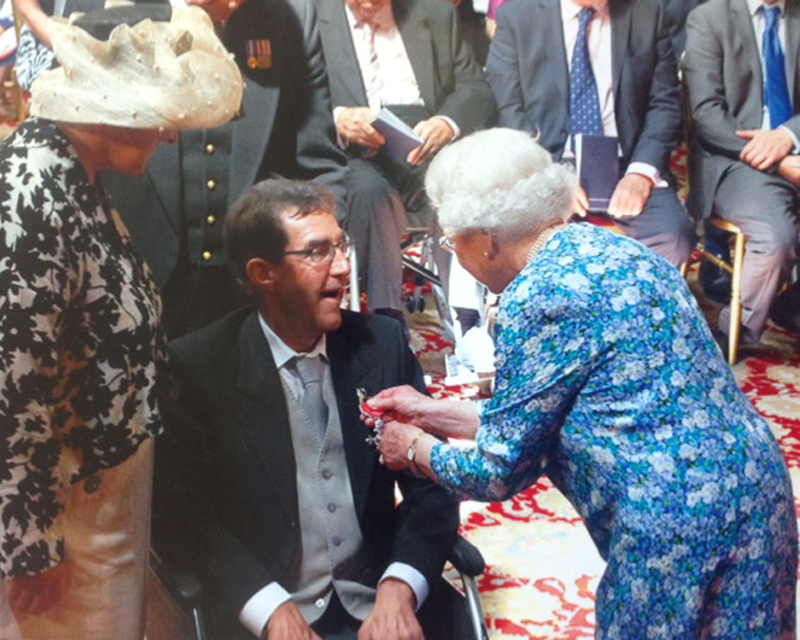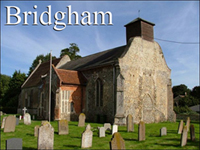
Bridgham village is over 1000 years old.
Updated 12th July 2019
Bridgham village came together for over two years, to fight a plan for a massive solar plant right next to this ancient village.It would have meant good arable land ceasing to grow food and instead growing subsidies. (see below)
Fortunately seven out of ten district councillors agreed with the village and rejected the plan.
We care deeply about the environment and support the growth of re-newable energy.
Britain is in the ideal position to use tidal energy - seabed turbines - totally predictable, dependable energy every day, regardless of whether the wind blows or the sun shines. (see below)
Wind and solar also have their place, but solar should be on the roofs of houses, hospitals, factories, supermarkets etc. Located where it is needed as the losses of transporting that energy are great. (see below)
This page tells the story of how a (now dissolved) company from Reading Berkshire were defeated by a small Norfolk villge.
If you are fighting a similar plan this page will almost certainly help you.
It will show how doing your research and building your case can be effective.
The battle comences at the bottom of this page and concludes at the top.
The solar plant would have been the size of 87 football pitches.
Covering nearly 170 acres with glass and plastic.
This would be on productive farmland in beautiful Breckland countryside for at least 25 years.
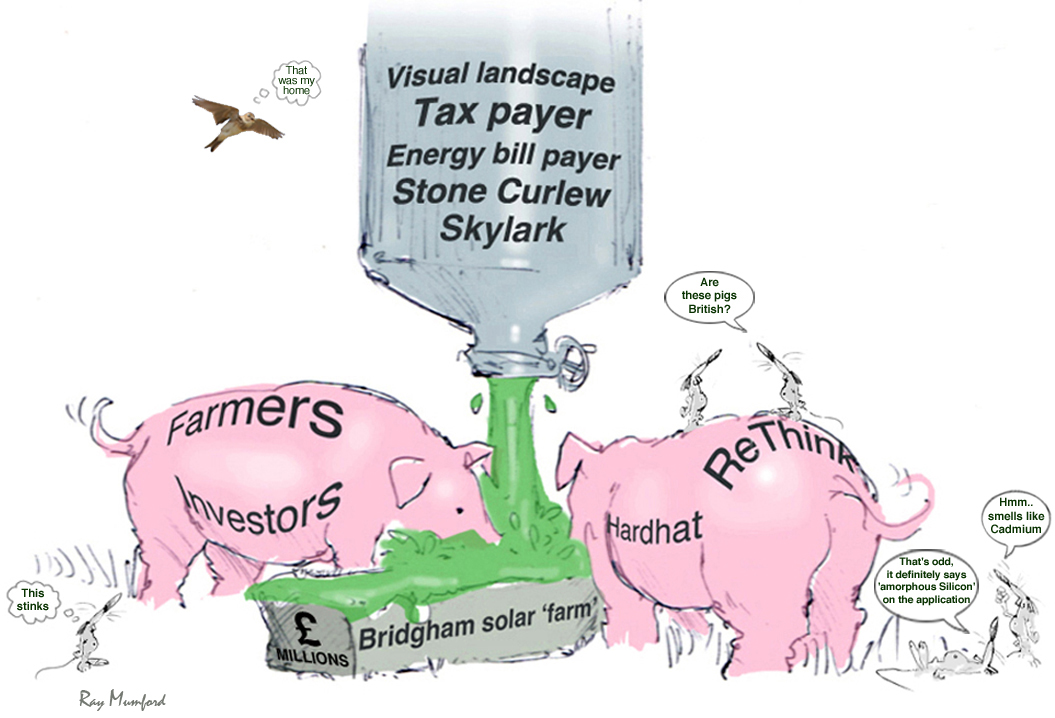
The story of the failed plan for Bridgham solar plant.
This page has a lot of information, maps and photos detailing why the huge solar plant
would have been totally inappropriate - please read on to
get the whole picture....

...and how the company behind it -'Rethink Energy'- is
connected to the FRACKING
industry.
(And knows more about birds than RSPB and BTO.)
With artists impressions (Rethink's and ours) of how it would look.
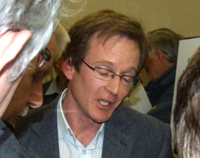
"Peter Grogan"
Quote by Peter Grogan of Rethink Energy Ltd...
“Just
because the local people don’t want it,
doesn’t mean it’s not going to happen”
Bridgham village hall March 2014
Quote by Peter Grogan of Rethink Energy Ltd...
a quite extraordinary misapplication of planning policy."
“We have every confidence the application will succeed on appeal.”
Diss Express March 2015
There has been no appeal.
This is a further embarrassment for Peter
Grogan.
(see below)
Peter Grogan is a project management lawyer.
On 20th January 2015
(the day
after Bridgham solar farm was refused)
Peter Grogan incorporated a new company - "PJG Legal Services
Ltd."
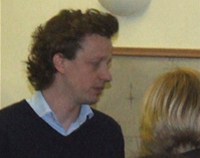
"Joel Tomlinson"
At
the same time Peter Grogan set up Rethink Energy Ltd., he and Joel
Tomlinson also set up
"Brighter
Energy Investments Ltd."
We watch this company with interest.
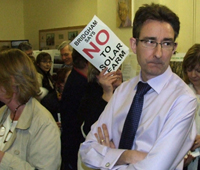
"Nick Sutcliffe"
Nick
Sutcliffe who works for 'Hardhat' has tried to deal with public
relations for Rethink Energy Ltd.
and Cuadrilla’s
lobbying firm PPS Group.
He has
lobbied the Department of Energy and Climate Change to garner
political
support for FRACKING.
(see below)
ITV Anglia News
The
firm behind an £8 million solar farm near Newmarket
says large sites in the countryside, like theirs,
are an inefficient way of creating electricity.
The
company says around two thirds
of the energy created by
the site at Red Lodge is lost when
it's transported.
(the losses are incurred when it is put through inverters and then transmitted to the grid)
And
at this time of year it is producing electricity only 12% of the time.
Tim
Dobson, from Switch2Renewable, says that means it's not producing enough
electricity to be useful to the National Grid.
He
said solar should be on rooftops where the energy can be used 'on site'.
ITV Anglia News - 3 - 4 March 2015
(click link below)
Newmarket solar farms branded "a waste of money" by the company that built them.
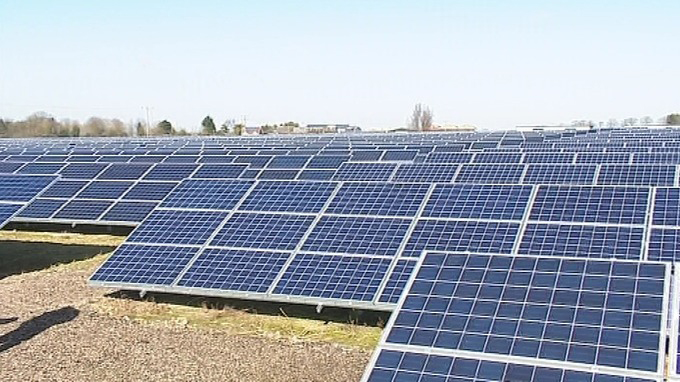
The Red Lodge site in
Newmarket. Credit: ITV News Anglia
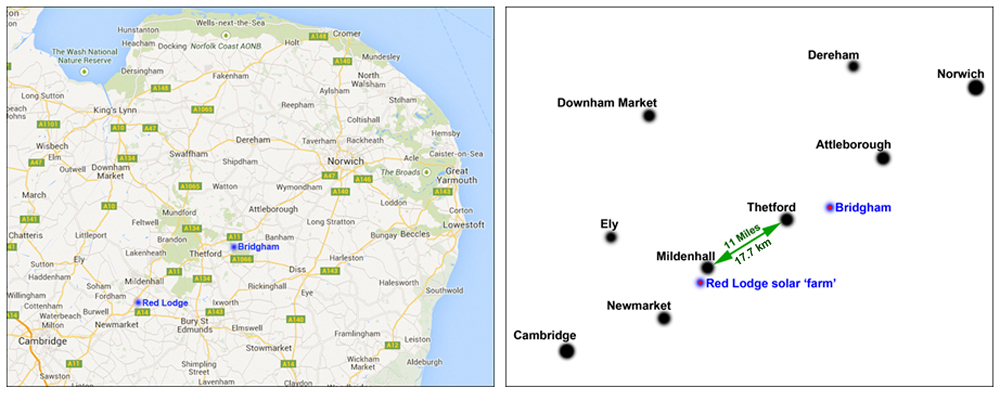
The above shows how close Red Lodge is to Bridgham.
If it
does not work in Red Lodge it will not work in Bridgham.
If a solar 'farm' is a 'waste of money' in Red Lodge
Then a solar 'farm' would be a 'waste of money' in Bridgham.
This is unequivocal evidence that....
Solar 'farms' in this part of the UK are no use to the national grid
when we most need electricity.
Previously....
The
primary
concern for Bridgham was the proposed huge industrial
solar plant.
(see below)
But common sense has
prevailed.
On January 19th 2015, the 'Magnificent Seven' Councillors refused the planning application.
The vote was seven against, three in favour.
On behalf of the great majority of Bridgham
residents we would like to thank those seven councillors who,
so eloquently, made the case as to why this development should not be
allowed.
(see below)
Considering what is going on elsewhere we are
lucky to have seven councillors who have a sensible long term attitude,
know the importance of the Brecklands and still believe in democracy.
A statement from Breckland Council read:
“Members of the Breckland Council Planning
Committee refused the application as they considered the proposed
development to be contrary the Council’s adopted policies in respect of
amenity (DC1) and (CP11).
These policies require the highest protection of the Brecks landscape
and the Committee determined that
the impact of the solar farm on the undulating site, which is adjacent
to the village of Bridgham,
was unacceptable and would result in a prominent and alien feature in
that landscape.
“Considering the matter of agricultural land and the impact on food
production, Members concluded that
the development would result in the loss of large areas of grade 3 land
which is considered to be of good to moderate
quality and had previously been actively farmed.
The loss of such land is not supported by the “National Policy Planning
Framework requirements which encourage
the use of previously developed land or poorer quality land over the
better quality land areas for solar farm developments.
“Members noted that the council had received 141 letters received objecting to
the development with only 17
supporting it.”
(Diss Express - 8th March 2015)
Links
Dissexpress
- developer confident bridgham solar farm appeal will succeed - 8th
March 2015
Dissexpress - bridgham solar farm proposals rejected -
23rd Jan. 2015
The District Council have published their reasons for refusing
ReThink's planning application.
The full text of the reasons can be found on the Council's Planning Application Search website http://www.breckland.gov.uk/content/planning-application-search under application reference 3PL/2014/0589/F.
The following is a summary of the reasons given.
The
site and its surrounding area have key features of the open
arable landscape of the Brecks, which the Council are committed
to protecting.
The proposed solar farm would be an alien feature in the
landscape, detracting from its integrity and open character.
Notwithstanding the proposed screening of the development,
the solar farm would be visible from a number of viewpoints on
adjoining public roads.
The harm caused to the landscape character of the site
would be considerable.
The proposal would also cause significant and unacceptable
harm to the character and appearance of the surrounding area.
The proposal would cause substantial harm to the rural
setting of Bridgham.
The proposal would result in the loss of a significant area
of productive arable land for at least 25 years.
The construction phase of the proposed solar farm would
cause an unacceptable level of disruption, inconvenience and
disturbance to local residents.
The proposal would at times give rise to activity and
noise, which would impair the tranquillity of the area.
At the planning meeting on 19th January 2015...
Councillor Chapman-Allen challenged some of the information provided by the applicant which conflicted with information on the DEFRA website.
Mr Grogan (of Rethink) clarified that the
figures came from the landowner and his advisor.
He apologised if they were incorrect.
(Pete Grogan is a project management lawyer)
Mr. Grogan further pointed out the key benefits which included:
..... rich and varied habitat for skylarks, etc.
Mr. Grogan seems to know more about these species than both the RSPB and BTO.
(see
below)
What follows is the story of the long road to this outcome.
It gives some idea of the relentless and unreasonable stress imposed on the residents of this beautiful part of Norfolk
by a company in Berkshire - Rethink Energy Ltd.
How is "Rethink Energy Ltd." who claim to be 'green' connected to
the FRACKING
industry?
See photos and links below.
‘Statement of Community Involvement’
It is full of 'untruths' and spin.
According to this document – the 'Drop in consultation'
was 'positive' and
successful.
See the
photos below which show what really
happened.
|
THE CASE FOR THE
SOLAR PLANT
- An opportunity to generate power not needed in East Anglia (we have a surplus) but only on sunny days, when it’s not needed anyway, at a wholly inappropriate rural site. - Last chance for farmers to take advantage of a misguided, discredited and soon-to-be-ended Government subsidy scheme which will pay them enormous amounts of taxpayers’ money, for 25 years, for not farming productive land. - Opportunity for ReThink Energy (based in Reading) to make enormous amounts of money when they sell this project on, probably to a consortium of foreign* investors. *or for what other reason are there dozens of visits to Bridgham Village website every week mainly from Brazil, but also from many other countries in South America and China etc etc… idle curiosity? |
THE CASE AGAINST
- An industrial development of any type, let alone one on this massive scale, sited so close to an historic rural Breckland village, is in direct contravention of Breckland District Council’s own policy CP11, (Protection of the unique Breckland rural environment) which is unqualified and has no exceptions or provisos. The rationale of Policy CP11 requires the refusal of this application. - There is no local, county, regional or national energy production target driving this specific Bridgham project, and absolutely no need for it at all, whatsoever, on energy requirement grounds within East Anglia. It is purely an exercise in speculative investment designed to maximise opportunity revenue for a few, from a now discredited subsidy regime. Better sites exist, if one really must be found. The vast ‘soon to be vacant’ RAF Mildenhall comes to mind. - The removal of productive farmland from agricultural use for a minimum of 25 years defies logic, when contemporary reports voice concerns about our Nation’s future ability to feed itself. Accordingly, this proposal is against current Government policy, which favours brownfield sites and rooftops for solar panels. - The over-riding majority of local people who would have to live with this thing on their doorstep for (at least) the next 25 years are united in their opposition to it. The formal objection of Bridgham Parish Council, a petition, large banners, and numerous posters voicing residents’ objections visible in most houses, the Village website, and the plethora of written objections confirm the truth of this. The Village is supported in its objection by local Parish Councils. The mysterious sudden appearance of “Yes to Solar Farm” posters high on telegraph poles, and a linked Facebook campaign claiming local support for the project carry no weight. Only one house displays a “Yes” poster. - The rare habitat enjoyed by both the Skylark, and Stone Curlew (both of them protected species which require open field sites, in order to see approaching predators) would be rendered unusable if covered by solar panels, and both species would be displaced. RSPB and BTO have recently confirmed their concerns in this regard. - The rural amenity of this historic Breckland village, loved for its rural setting and beautiful views over the rolling Breckland farmland of the Thet valley, would be ruined in an instant for a generation, (or longer if after 25 years it were to prove impossible to return the industrial energy collection site to agricultural use). Bridgham villagers’ strong sense of place, and pride in their Village (c.f. Village Life, the village’s own 2010 publication celebrating over 1000 years of history) would be irredeemably damaged at a stroke, by those based afar, or abroad, who care nothing for our local environment and the wellbeing of its inhabitants. - Breckland District Council is a locally elected body, charged with making the correct decisions on important matters within their area of responsibility, for the good of the local people affected by those decisions. Any decision concerning the establishment of an unnecessary industrial power collection facility (which would financially benefit only a privileged few), in a protected rural area next to an historic village, to the dismay of the majority of local residents, taking productive agricultural land out of production, and ruining the rural amenity enjoyed by those actually living there, should be a foregone conclusion. Even recently stated Government policy is now against all such applications to misuse agricultural land in this way, favouring brownfield and rooftop sites. BDC’s own Policy CP11 is unqualified; there are no exceptions or provisos. It should not be weighted against any perceived benefits the proposed solar farm may be claimed to have. It is the deciding factor, which should have prevented all ideas of a re-submission of the 2013 planning application. Instead, and without heeding the advice of the planning officer, RE:think Energy Ltd went ahead with a re-submission and in so doing have caused much anguish in the Bridgham community, not to mention the collective hours which residents have been forced to expend in opposing this hideous proposal. All logic and common-sense directs this application must be refused, and the inhabitants of Bridgham, part of the BDC electorate, await the confirmation of that refusal decision by their own elected representatives: |
Refusal – the only sensible outcome
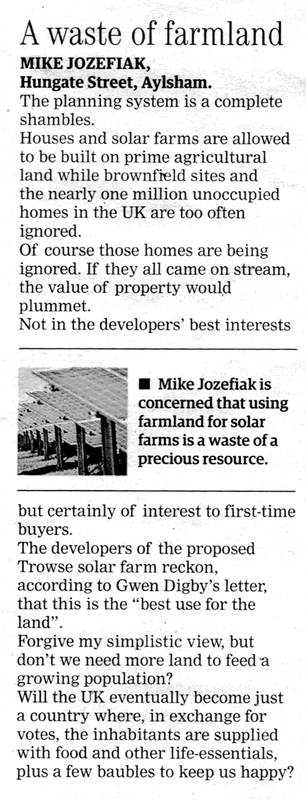
Eastern Daily
Press 12th February 2015
See also -
Eastern Daily Press 10th March 2014 below.
The latest revised application shows an unspecified number of
panels are now to be mounted
on heavy concrete bases instead of poles.
(This is to avoid doing an archaeological survey.)
Is it a third? half? or all? This is a major change to the plan and could mean a huge increase in HGV's to the site.
This can also affect water 'run off', wildlife, damage to soil etc.
The calculations regarding these
issues in the application are now invalid.
How can a decision be made on such a vague planning application?
Granting planning permission under these circumstances would be undemocratic and outrageous.
This
means that a large area of Breckland would not only be covered in glass
and plastic, but also in concrete!
The original application was recommended for refusal.
Jemima Dean (who works for Capita who run the planning dept.) said -
"no amount of screening would make
the plan acceptable."
But now Jemima Dean recommends approval.
Why?
Apart from a small reduction in number of panels and a lot more hedgerow planting it was the same plan in the same place.
The vast majority of local residents and parish councils are against this.
Liz Truss,
the Environment Secretary, tells The Telegraph that solar farms are
putting Britain's "beautiful" rural landscape at risk.
From
New Year’s Day farmers will be barred from claiming taxpayer-funded
subsidies in an attempt to preserve Britain’s “beautiful” landscape and
reduce the number of black panels in the countryside.
27 Dec 2014
Eric Pickles,
Secretary of State for Communities and Local Government, has stated...
There should be no
more large ‘solar farms’ on agricultural land.
So why does he not stop this dreadful application? He has the power to do so.
The
planning meeting of 24th November for a decision on the proposed SOLAR
PLANT was
deferred until 22nd December 2014.
This
deferral was on a point of
planning law, in particular Regulation 16(5) of the EIA regulations and
is a very serious matter.
It was then postponed AGAIN
through a procedural error.
This
must be a great source of embarrassment to Peter Grogan
of Rethink.
Peter
Grogan
is a
project management lawyer.
It must be even more of an embarrassment to their agents - Savills.
This will delay construction to beyond bird nesting season (Construction is only allowed between October and February).
Therefore work on the site would not be allowed to begin before October 2015.
This will put the development in doubt given that after March the
financial returns will be
far more of a gamble for any investors to
finance the project.
The earliest
construction could be completed is February 2016.
(We were told by Peter Grogan that it would take approx 4
months to build)
There
is little sun at that time of year,
generation would be a trickle,
it would be April or May 2016 before it produced much electricity.
June 2016 would
be the earliest
they would be likely to see any
return on investment.
Anyone thinking of investing in this project must be mad.
Qualquer um pensando em investir neste projeto deve estar louco.
'Rethink' are claiming this project is backed by
'Greenpeace'
and 'Friends of the Earth'.
Both organisations
have told us they do NOT give 'blanket
blessing' to solar 'farms'.
(see below)
At the planning
meeting on 19th January 2015
(when the application was refused)
Pete Grogan of Rethink pointed out the key benefits which included:
..... rich and varied habitat for skylarks, etc.
'Rethink' claim this project is backed by the RSPB.
Rethink claim Skylarks "will nest between the panels"
The
RSPB have confirmed they have NO
evidence that skylarks will nest on solar 'farms'.
Richard
Winspear
Senior Agricultural Adviser
RSPB
And from British Trust for
Ornithology –
“The avoidance of
vertical structures by skylarks is so well known that
I would have to search a
long way back through the scientific
literature to find published evidence.
Likewise, stone curlews are well-known as open-country birds.
So I am not familiar
with any specific research into birds on solar farms, but I am sure
that the (solar) farms I have seen (in the UK and Germany) do not
provide suitable habitat for these species.”
Dr Gavin M. Siriwardena
Head of Land-Use Research
British Trust for Ornithology
(Skylarks and Stone Curlews threatened - see below)
But Rethink’s environmentalist Dr Iain Barr has refused to answer our question -
‘Given that stone curlews already nest on the site, will building a solar farm result in more or less stone curlews’?
Rethink’s environmentalist Dr Iain Barr has refused to comment on the use of the land after 25 years.
Meaning it could be classified as 'brownfield'. This could mean anything could be built on it, from housing
to
a chemical factory, negating any claimed
benefits of 25 years under glass, plastic and concrete.
What further evidence do BDC require to show this industrial development will severely reduce the habitat of these endangered species?
Rethink's 'Sequential Analysis Study'
claims no alternative sites
are available.
This is a further
example of either slipshod work, or deliberate distortion of the facts.
(see below)
The Green Party
"Although the Green
Party
broadly favours solar energy generation, given the relatively low
efficiency of generation at UK latitudes, solar collectors should only
be located where the space can't be used for anything else.
By all means put them urban
roofs, municipal and industrial buildings in towns and on farm
buildings in the countryside.
However
we would rally to protect productive arable land, particularly when
this is wildlife rich and set within the valued landscapes of our
county."
Louis Stephen
Worcester Green Party
Worcester News -
solar panels
The solar plant would be
the size of 87
football pitches
Covering nearly 170
acres with glass
and plastic.
This would be on productive
farmland in beautiful Breckland countryside for at least 25 years.
By Farmers Wright of Brettenham and Rethink Energy of Reading Berkshire.
The overwhelming
majority of local residents are opposed.
(There are approx
130 dwellings in Bridgham - so far well over 200 objections have been lodged.)
(It is Immediately adjacent to Bridgham village - see maps below)
"A planning application for the farm was
withdrawn following widespread objection last year.
Breckland Council officers had recommended refusal
on the application."
(Diss Express 24th March
2014)
'Rethink' claim they are doing this for
environmental reasons and go on at
length about being 'green'.
'Rethink' website is awash with warnings of climate change through burning fossil fuels.
And states...
"REthink Energy is an independent renewable energy company, dedicated to assisting Britain in the fight against climate change through the development of considered, appropriate renewable energy projects around the country."
"WE HAVE THE ENVIRONMENT AT HEART"
Yet 'Rethink' brought PR man
Nick Sutcliffe,
Guildford Conservative Councillor and
FRACKING
promoter,
to Bridgham to try to sell us their plans.
Nick
Sutcliffe, who represents Cuadrilla’s
lobbying firm PPS Group,
has lobbied the Department of Energy and Climate Change
to garner political support for FRACKING.
Cuadrilla
lobbyist is Guildford District Councillor
A lobbyist for UK fracker Cuadrilla is a councillor at Guildford
District Council (GDC). As well as his public duties,
councillor Nick Sutcliffe also
works for PPS group, one of Cuadrilla's 'public relations' consultants.
PPS cronies often appear next to Cuadrilla managers at public meetings
in Lancashire and Sussex.
Sutcliffe made a personal
appearance at a contentious public meeting in Balcombe in 2011;
more recently he has contributed various postings relating to shale gas
on PPS's blog http://www.ppsgroup.co.uk/blog/2013/03/budget-measures-to-back-shale-gas-development/
PPS also runs Cuadrilla's website http://www.cuadrillaresources.com/privacy-policy/;
until recently Sutcliffe
authored
several of the pdf documents available for download from the site.
Sutcliffe serves on GDC's
planning committee. Cuadrilla's fellow fracker Igas have a licence
block within GDC's jurisdiction;
it's unknown whether Sutcliffe has had any dealings with Igas.
Here's smiling Nick on GDC's
website - http://www.guildford.gov.uk/index.aspx?articleid=9975&lnk=45.
In his register of interest
Sutcliffe says he's a
'freelance PR consultant'.
Courtesy Frack Off (UK) facebook page
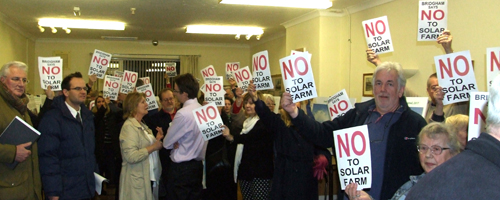
He failed.
(see photos below)
If 'Rethink' were 'environmentally concerned' they would have nothing to do with this man.
The authors of the Rethink's 'Sequential Analysis Study' concluded from a purely desk exercise that no alternative sites were available.
That conclusion is unsatisfactory as no attempt appears to have been made to identify by inspection any brownfield sites either within or beyond the selected study area.
Potential, more suitable, brownfield and lower grade agricultural sites closer to grid connection, which our own more competent analysis has shown to exist, (a fact which has been fully disclosed in a letter to Breckland District Council) have not been considered.
This is a further example of either slipshod work, or deliberate
distortion of the facts.
Either way, the credibility and competence of ReThink are further shown
to be less than acceptable.
('Sequential Analysis Study' is required by The national Planning Practice Guidance (PPG): Renewable and Low Carbon Energy.)
Quote by Peter Grogan of Rethink Energy Ltd...
“Just
because the local people don’t want it,
doesn’t mean it’s not going to happen”
But 'Rethink' website says...
"ReThink always endeavour to adapt and update our project plans following public consultations to ensure we’re not missing anything vital to the local community and that the local community is happy. Whether we need to change our site location, adjust some of the layout, or ensure that we’ve tailored the construction plan to suit local priorities, ReThink will always try to help."
'Rethink' website also says...
In order to fully address these matters, the application was withdrawn and we have spent the last four months looking closely at the issues raised to ensure we can fully address the points made."
Their plans are hardly changed apart from more blocking of our views.
But they have not addressed the main point that most residents made....
"It will ruin our beautiful countryside and we don't want it!"
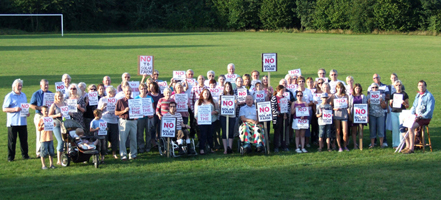
You can add your
objection by using the link below.
(where
planning application and comments can also be viewed)
http://planning.breckland.gov.uk/OcellaWeb/planningDetails?reference=3PL/2014/0589/F
Or by email to planning@breckland.gov.uk
Or you can object in
writing to BDC Planning Dept. Elizabeth House, NR19 1EE
Quote - Planning Application -
3PL/2014/0589/F
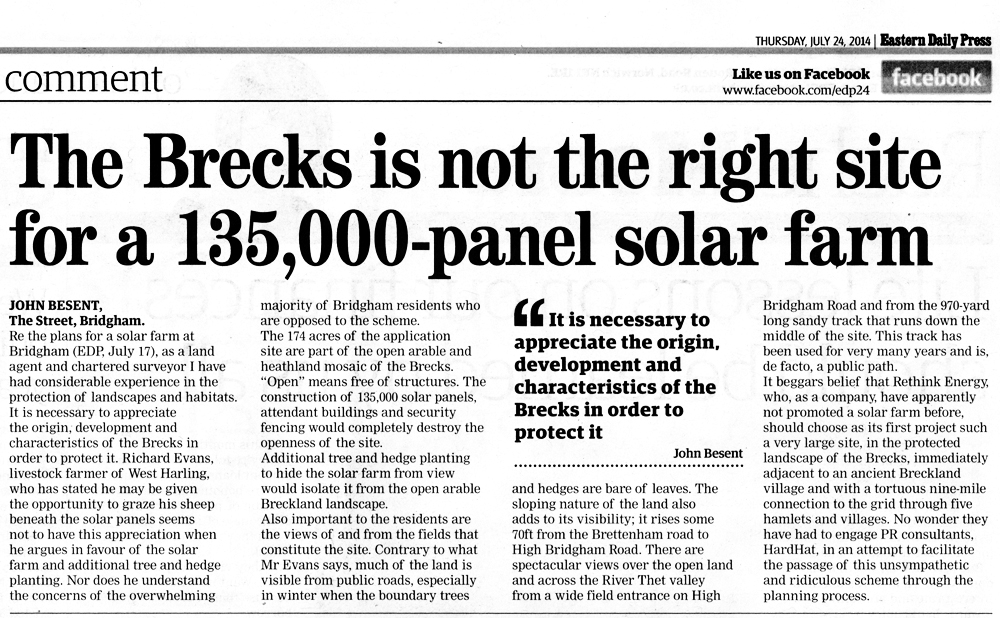
Eastern Daily
Press 24th July 2014
In
certain parts of the world Solar Pv works well.
(see below)
But UK Solar 'farms'
produce very
little electricity
in
the winter months
and,
of course, none when it is dark.
We cannot store any of the electricity produced by these plants.
When do we need electricity the most?
Could it be when it is cold and dark?
http://www.cpreoxon.org.uk/news/item/2248-solar-farms
Solar should contribute to the 'renewables mix' but on rooftops and brownfield sites, not agricultural land that we need for food.

Brazil
has strong sunlight, with an average irradiation rate that’s almost
double that of Germany, the world leader in solar installed capacity,
according to the U.S. National Renewable Energy Laboratory.
Brazil is now investing in
solar power.
The UK has a coastline that is ideal to
exploit tidal flow power generation.
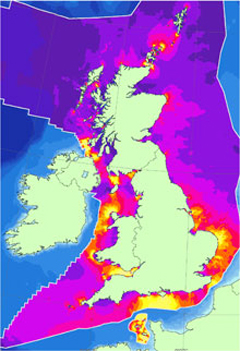
UK tides ... stronger tides are yellow and red. Image: DTI
There
is an immense potential resource of clean energy from the tidal flows
around the UK:
conservative
estimates suggest there is at least five gigawatts of power, but there
could be as much as 15GW, equivalent to 15 million average family homes.
Tidal
generators can harvest the energy of these moving streams, with the
added advantage that the resource is, unlike wind, predictable.
http://www.theguardian.com/environment
The
photos below show the chaos that ensued when Rethink
from Berkshire
and their PR company 'Hardhat' from London
thought they could sell
Bridgham the same monstrosity again
with pretty pictures and clever words.
Nick Sutcliffe was witnessed telling
the reporter present that he could not use
any photos taken at the 'meeting' in his newspaper.
Sutcliffe knew they would show that it had been a Public Relations disaster For 'Hardhat' and Rethink.
The reporter did not give in to Sutcliffe.
Rethink have tried
to manipulate the media to mislead
the
council into believing the project has been favourably received.
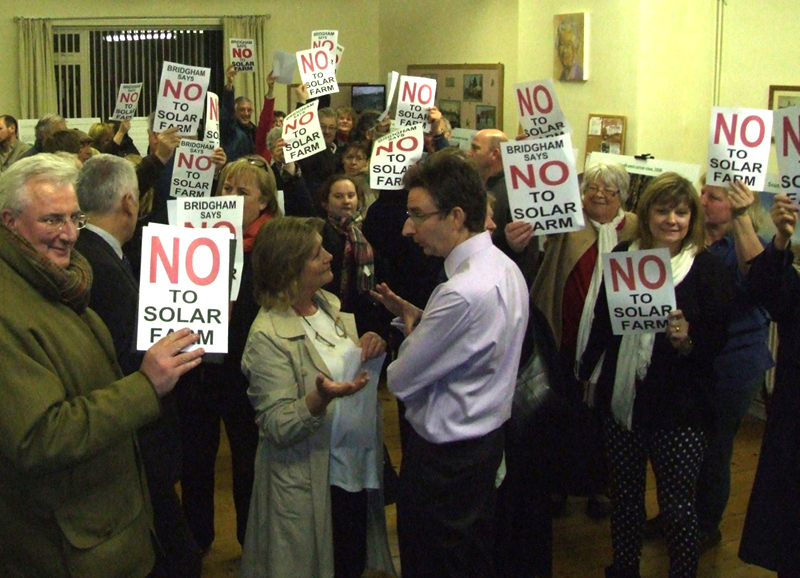
Bridgham
village hall, 6th March 2014.
'Rethink' try to 'sell' Bridgham the solar 'farm' again.
This is Nick
Sutcliffe of 'Hardhat' who specialise in - 'Managing political, media and
community relationships'.
The response is obvious - NO.
Other websites have taken an interest in the
activities of Conservative councillor Nick Sutcliffe.
Click
link below
Why is a Guildford District Councillor running
Cuadrillas website?
"Nick
Sutcliffe, who represents Cuadrilla’s lobbying firm PPS Group, has
lobbied the Department
of Energy and Climate Change to garner political support for FRACKING.
Mr
Sutcliffe is also a councillor who serves on the planning committee at Guildford
District Council."
Click link below
Nick Sutcliffe and Cuadrilla in Balcombe - a fracking
PR disaster.
Nick Sutcliffe page on 'Hardhat' website says....
Nick has a 15 year
track record of success advising development clients on the process of
securing planning consents.
He has worked in many of the most controversial development sectors
including prime central London residential,
large strategic land allocations and on-shore oil and shale gas exploration.
As
a public affairs specialist, Nick also provides Westminster government
relations advice, specialising in
energy and environmental issues.
Nick has also been an elected local authority member since 1999 and has
served over 12 years on a planning committee
as well having been the Cabinet Member for planning policy and a Committee Chairman for six years.
If Rethink were really concerned about the environment would they hire this man?
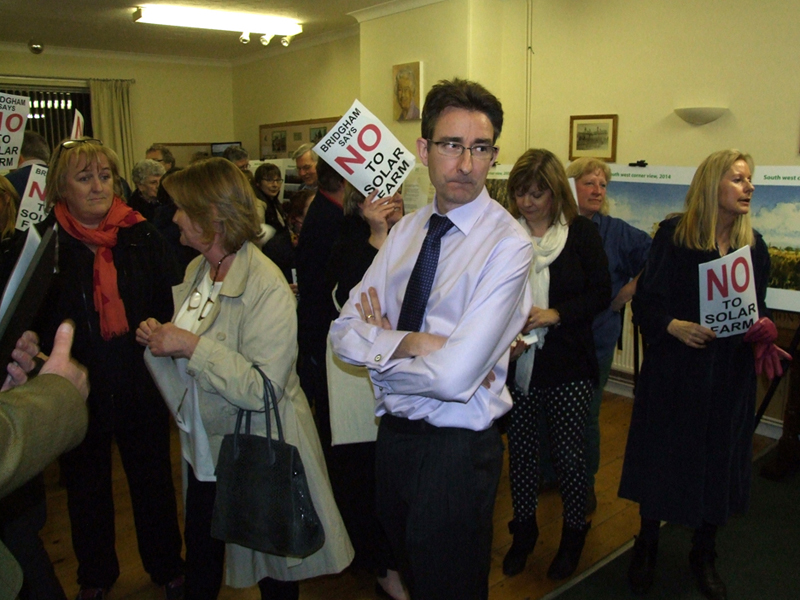
"It's my party
and I'll cry if I want to"
Nick Sutcliffe again.
It can be a lonely business trying to sell something no-one wants.
Rethink obviously thought that fronting the meeting with Nick Sutcliffe,
who helps the fracking industry get their way, would help.
It
did not.
'Hardhat' website says...
"Effective crisis management requires experience, good judgement and a real understanding of the political, media and community context."
'Crisis management'
Nick Sutcliffe style (below).
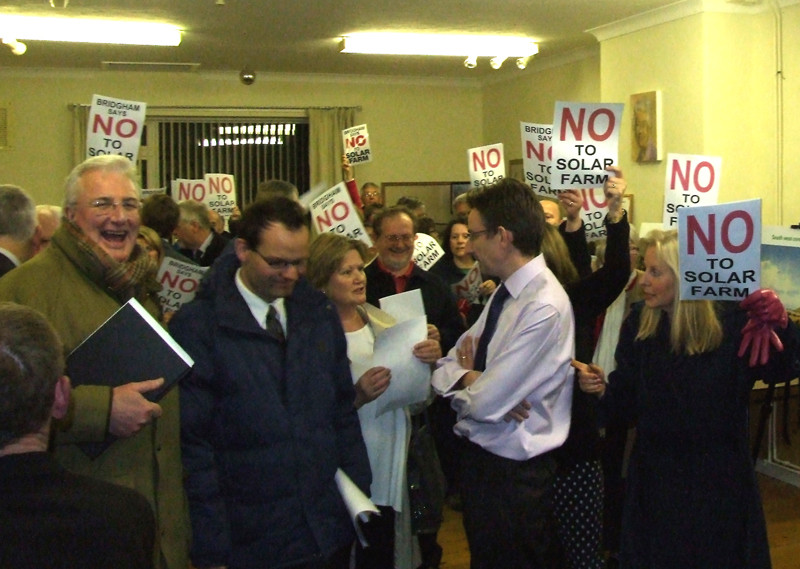
(And this was before we knew he was a PR man for the FRACKING industry)
Below is from a link on 'Rethink' website 16th October 2014.
"UK to allow fracking companies to
use 'any substance' under homes.
Proposed amendment in infrastructure bill would make mockery
of world class shale gas regulation claims, campaigners say"
We wonder who could have lobbied for that?
'Hardhat' website says...
"HardHat’s reputation was established
through delivering success in planning.
Our expertise in the ‘politics
of planning’ means we can offer the most effective strategic and
tactical advice to secure
land and planning permissions."
'Rethink' website says...
All the clean green electricity produced is used locally. Local residents’ will be getting clean, green energy that they can use with pride.
We would like to know how this is possible as it would feed into the national grid ten miles away.
'Rethink' website says...
They are backed by 'Friends of the Earth' and 'Greenpeace'.
Having
consulted both organisations they have stated that they do not
give 'blanket blessing' to solar farms, in general terms they prefer to
see brownfield sites and rooftops used.
'Rethink' website says...
"REthink Energy always works closely with bodies like Natural England to ensure wildlife is protected and in the past we have taken a wide range of measures to ensure this."
'Rethink' website says...
"The key to ReThink Energy’s success is that we always work in consultation with local people and act sensitively to the needs of local residents, land owners and parish councils."
'Rethink'
website says...
"ReThink Energy is adamant that our solar farms always play an
essential role in resting the land,..."
What else has 'Rethink Energy' they done?
(Rethink Energy Limited was incorporated on 1st June 2012)
has done prior to this project.
So - Question to 'Rethink' -
As you claim that 'Rethink' have built solar farms before.
quote -
"At ReThink Energy, we prefer, wherever possible, to provide
a dual use for the solar farm. We often underplant with..."
"We always work in consulation with local people....etc."
Perhaps you can tell us, and Breckland District Council,
What else 'Rethink Energy' has done and how the project turned out?
Where are the other 'Rethink' solar farms?
We await your response.
Further question to 'Rethink' -
On your website you state you have three other projects -
Listed as "A SELECTION OF OUR PROJECTS"
"Merthyr Two solar project
White Horse solar project
Blackberry Farm solar project"
We can find no 'Rethink' connection to any projects with these names.
Perhaps you could explain why you claim this?
You appear to be a one project company.
Again - we await your response.
Founder of REthink Energy, Pete Grogan, said:
“It
was a pleasure to meet so
many local residents and to have an opportunity to better understand
their views which we will take into account.
“It was also great to be able to
get some feedback on the community benefits associated with the project
and we are pleased that these have been so well received.”*
“Unfortunately the evening was interrupted by a small minority of
objectors. It is a shame that these objectors sought to deny their
neighbours an opportunity to engage with us.
“We apologise to anyone who felt unable to speak to us while this
disruption took place.”'
Diss Express 13th March 2014
*The Photos tell a different story.
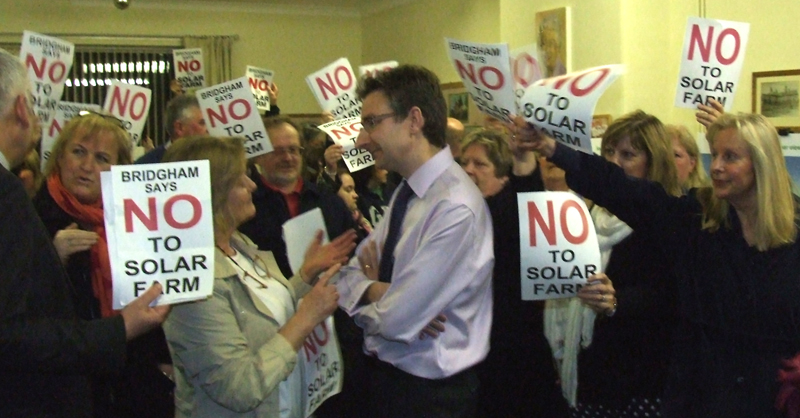
Does this look like a 'well received' project? (Nick Sutcliffe again)
Mark Dickenson, Bridgham Parish Council
chairman,
was also in attendance.
“Nobody
asked us what we thought. They just told us what they think they are
going to put up,” he said.
“That is not consultation in my eyes. I thought consultation was a
two-way thing.
They will say it was a success because a lot of people
turned up.
“It was not interrupted. People just asked ‘can we ask questions?’ and
they refused to answer group questions, and would only speak to people
one-to-one.”
Diss Express 13th March 2014
These were the people (below) who descended on Bridgham
to promote
the solar 'farm' on 6th March 2014.
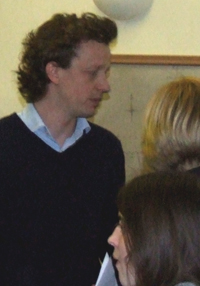 "Joel Tomlinson" Rethink energy |
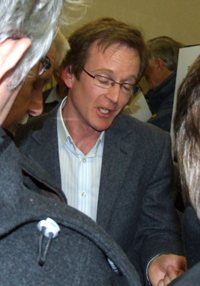 "Pete Grogan" Rethink energy |
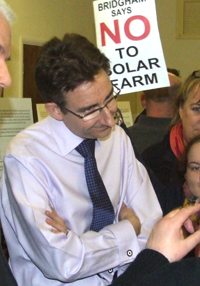 "Nick Sutcliffe" Hardhat |
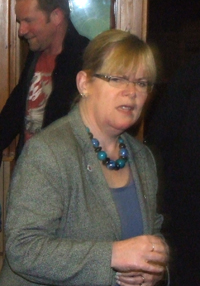 "Sarah Hill" Ward Hill |
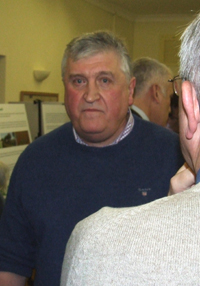 Refused to give his name. He is "Richard Atkins" of 'Red Triangle' and was part of Rethink team. |
They appeared to be the only people present (other than farmers Wright) who were in favour of the development.
Their drive back to London and Berkshire was not a happy one.
Members of 'Rethink' team told us the solar farm could be owned by pension funds, private companies etc.
This industrial development could be sold to anyone - Chinese, Russian, European, Brazilian - who knows?
How much would the owners care for Bridgham and the Brecklands?
'Rethink' are in Berkshire, and they don't care.
These are Rethink's 'artists impressions' of how they claim the site
would change if they go ahead.
These were shown at the public meeting and are in Rethinks
planning application.
Look at the dates.
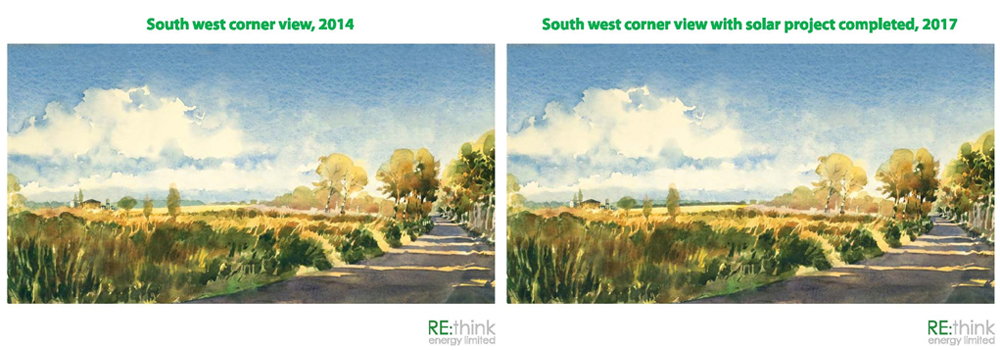
Is this 'spot the difference'?
How is this possible? How stupid do they think we are?
Here are our 'artists impressions'
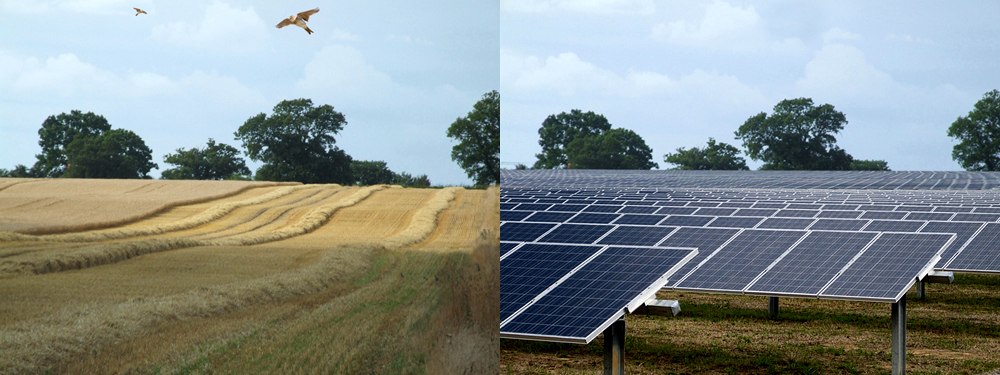
Ours have titles. This one
is 'Goodbye Skylark'
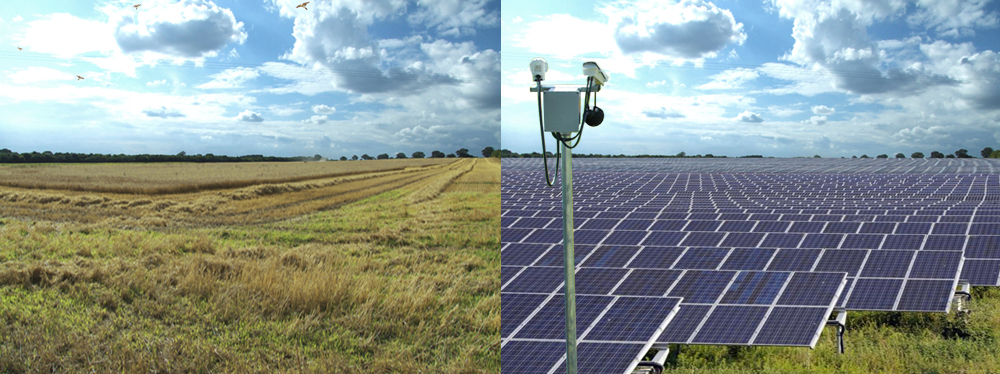
Ours have titles. This one is ''Sea of glass and plastic"
Stone Curlews and
Skylarks
Rethink claim Stone Curlews and Skylarks will be encouraged to nest on the site.
'Rethink' website says...
"...attract
skylarks. The birds are able to
nest between the panels
and
benefit from the reduced levels of human activity."
'Rethink' website says...
Common bird species such as sparrow and skylark facing decline in Europe. Solar Farms can protect them.
They link to
a Guardian article here...
Common bird species such as sparrow and skylark facing decline in Europe
The article does not mention solar farms.
Both Skylark and Stone Curlew already nest on these fields.
Both species will only nest on big open spaces as they need to see approaching airborne and ground predators.
Both species are endangered mainly due to loss of habitat.
Neither species will nest among solar panels.
From
RSPB website...
'Skylark'
"What
this species needs.
Mid-field
areas in which to nest and feed.
Skylarks occupy open fields to avoid
predators.
They cannot be conserved by measures taken
within 10 metres of the field boundary."
'Stone Curlew'
"It
is a bird of dry, open places with bare, stony ground or very short
vegetation.
Its UK strongolds are in Wiltshire, around Salisbury Plain, and in
Breckland, Norfolk."
Legal
status
"The
stone curlew is listed on Schedule 1 of the Wildlife & Countryside
Act 1981, which affords special protection at all times. It is an
offence to take, injure or kill a stone curlew or to take, damage or
destroy its nest, eggs or young.
It is also an offence to intentionally or recklessly disturb the birds
at or close to their nest during the breeding season.
Violation
of the law can attract fines up to £5,000 per offence and/or a prison
sentence of up to six months. In addition, the stone curlew is listed
on Annex 1 of the EU Birds Directive."
And RSPB website says....
"Large-scale solar 'farms' are a potential concern in sensitive locations, as they could reduce the suitability of habitats for key species."
The
RSPB have confirmed to us that they have no evidence that skylarks will
nest on solar farms.
'Rethink' are either
completely ignorant of these facts
or they just don't care.
Sheep Grazing
'Rethink' website says...
"Solar panels will be mounted in wide-spaced south-facing rows and raised one metre above ground to allow sheep to graze freely across the open site."
Quote from Keith Longmore CEng MIET MSEE...
"I
contend that the proposed sheep-grazing would be detrimental to the
site. It is well-known that sheep crop vegetation of a very low
level, exposing
any site to wind erosion and therefore over time making return to arable
use most unlikely (Wiltshire being a prime example of this effect).
The sandy soils of this area would make it very prone to such erosion."
Quote from walkingworld.com...
(Bridgham - Stonebridge - Peddars Way
- Bridgham)
"In
the Middle Ages much of The Brecks was destroyed by over- grazing
by sheep and rabbits. This led to sandstorms and in 1668 such a storm
obliterated villages. In Victorian times landowners planted belts of
Scots pine to stabilise the soil."
By Rethink's standards perhaps this could be their next project?
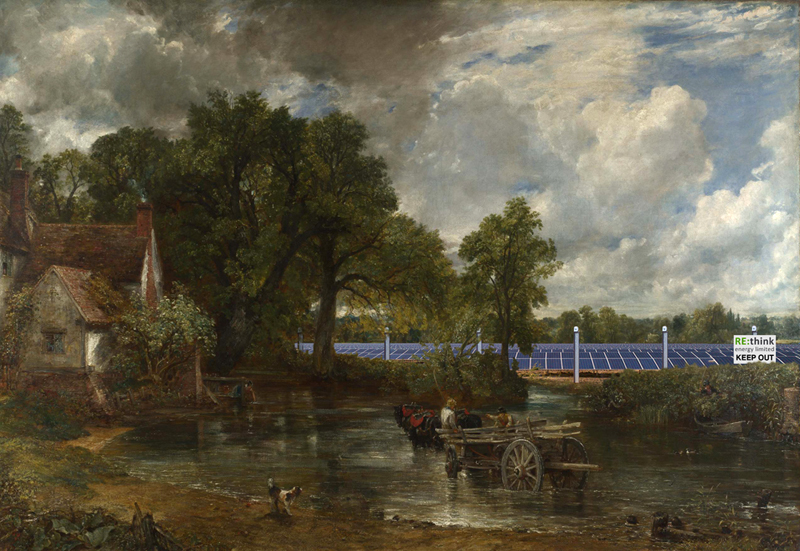
South West Norfolk
MP and Environment Secretary Elizabeth Truss
said...
“English
farmland is some of the best in the world and I want to see it
dedicated to growing quality food and crops. I do not want to see its
productive potential wasted and its appearance blighted by solar farms.
Farming is what our farms are for and it is what keeps our landscape
beautiful.
“I
am committed to food production in this country and it makes my heart
sink to see row upon row of solar panels where once there was a field
of wheat or grassland for livestock to graze. That is why I am
scrapping farming subsidies for solar fields. Solar panels are best
placed on the 250,000 hectares of south facing commercial rooftops
where they will not compromise the success of our agricultural
industry.”
(www.elizabethtruss.com
20th October, 2014)
There
are many, many houses in Bridgham displaying 'NO to Solar Farm' posters
in their windows and elsewhere on their properties, despite the fact
that these are often found to have been removed during the night, even
from private properties, and have to be repeatedly replaced. Two
large "No to Solar Farm" banners have actually been stolen.
A number of 'Yes to solar farm' posters have appeared on poles and
trees (mysteriously at night), and are still there. That is
because the good people of this village do not remove what is not
theirs, however:
None can be seen on any houses. Says it all really.
Bridgham residents have been called 'NIMBYS'
Rethink are in Berkshire (120 miles away) why don't they do it in their
'back yard'?
We say this should not be in anyones 'backyard'.
5th July 2014 Another
banner objecting to proposed solar farm has been stolen
in Bridgham.
It was cut down and taken from
private property on Friday night, 4th/5th July.
The vinyl banner, which measures 6
foot by 2 foot, has the words -
‘Say no to solar farm’ in black and red.
Anyone with information on the
whereabouts of the banner should contact Attleborough Police on 101 quoting
crime number 34571/14/1.
There are very few suspects as only 3% of Bridgham are in favour of the scheme.
A banner objecting
against a solar farm has been stolen in Bridgham.
Police
believe the incident happened some time between 10.30am on Thursday,
March 6 and 7am on Saturday, March 8. Stolen from a house in The
Street, Bridgham, the banner had been hung from a gate.
The banner, which measures 6 foot by 2 foot, has the words
‘Say no to solar farm’ in black and red.
Anyone with
information on the whereabouts of the banner should contact
Attleborough Police on 101.
Diss Express 12th March 2014
Bridgham - a village under siege. Please read on....
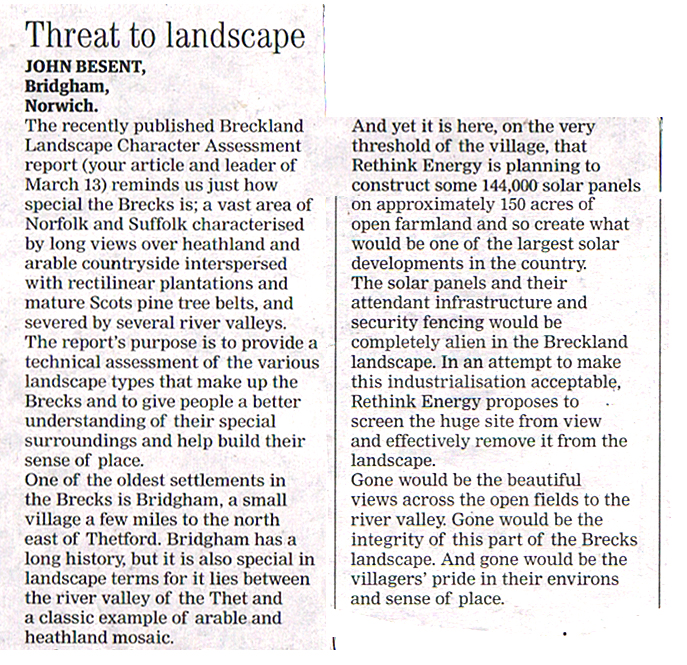
Eastern Daily Press 17th March 2014
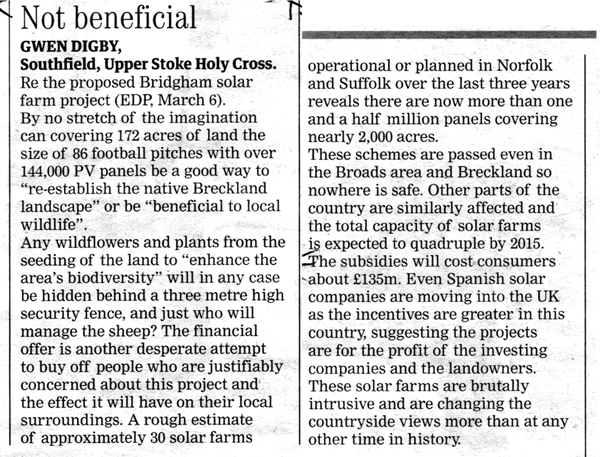
Eastern Daily Press 10th March 2014
To Mr. Pete Grogan REthink Energy Ltd.
Dear Mr Grogan,
Hall Farm Solar Project
We refer to your letter of 11th February, inviting Bridgham residents to register their interest in your Local Electricity Discount Scheme, and to the recent invitation to the drop-in session. The latter gave just a week's notice, which cannot be said to be in the spirit of engagement with the village community.
Your letter and its accompanying glossy, stylish brochure and response card display considerable arrogance. We say this because they suggest implicitly that the project will happen. You even refer to us as neighbours. We do not know what, if any, legal interest you have in the project site, but you are certainly not our neighbours. Whilst you make it clear that the discount scheme is subject to the project receiving planning permission, we consider that it is presumptuous of you to invite interest in the scheme in advance of providing full details of the project.
You do not say whether the solar farm would occupy the same land which was the subject of the withdrawn planning application. You just refer to land west of Bridgham and specify an area of approximately 60 hectares. This is some 10 hectares smaller than the area originally proposed, but the power output has increased from 30 mW to 36 mW. You do not say how this 20% increase in power generation will be achieved on a 14% smaller site. However, for the purpose of this letter, we are assuming that the project site is essentially the same as that which was the subject of the withdrawn planning application.
Your brochure states that “the site will be fully screened from view in a way that is consistent with the natural integrity of the landscape such that its character will be enhanced by returning it to its traditional state”. The drop-in invitation says something similar: “Revisions to the proposals include extensive enhancement of landscape screening consistent with the natural integrity of the Brecks landscape, such that the site will not be visible from the village of Bridgham or the surrounding area. These statements are absurd and gobbledegook. The natural integrity of the fields in question is their unimpaired state and the traditional state of the land is one which is open, cultivated and/or grazed. The construction of some 144,000 solar panels together with attendant infrastructure, security fencing and full screening will result in the opposite of what you claim.
A landscape is not an abstract thing; it is non-existent if it cannot be seen. The construction of a solar farm would cause great harm to the traditional landscape. Full screening would hide an eyesore, but it would also remove the fields from the landscape and break up its integrity. One cannot mitigate against the adverse impact of a solar farm on the open landscape of these Breckland fields. What villagers are opposed to is the loss of the open fields and the Breckland views which they provide.
You say that just one third of the land will be occupied by the panels. From the sky above the site this may be apparent, but from eye level the fields would be overrun with panels and the openness of the site completely lost.
The front page of your brochure states that the solar project is near to the village of Bridgham. This is misleading for the site is immediately adjacent to the village. Also disingenuous is the design of the brochure which gives the impression that the solar panels would make a positive contribution to the rural idyll portrayed.
Bridgham is a pastoral village straddling the river Thet and set within the beautiful landscape of the Brecks. It derives its amenity from these attributes, which are greatly valued by the community. People choose to live in Bridgam not because it has a pub, which it hasn't, nor because it has a village shop, which it also hasn't, but because of its setting in the landscape and the pleasure which that landscape provides. Your solar project would significantly damage the landscape and thus the amenity of the village and the enjoyment of its residents. A financial benefit would not replace the loss of amenity. In any event, the loss would endure for 25 years, whilst your LEDS would last for just one fifth of that time.
You say that the majority of the land is Grade 4. What you don't say is how much of the land is Grade 3 (moderate to good quality) and whether any of the land is Subgrade 3a (good quality). By inference, some of the land is at least moderate quality and, therefore, it is incorrect for you to state that the solar panels would be installed “on circa 60 hectares of low grade agricultural land”. Some sheep grazing already takes place and it is open to the Wright family to extend sheep grazing to all of the land and to farm it organically. It does not need to be covered in solar panels for it to be farmed in a more environmentally sensitive way.
It is outrageous of you to describe irrigation by licensed abstraction from the Thet and the application of fertilizers as industrialised farming techniques, which they are not, when you are proposing an industrial use of the land for the generation of electricity through the construction of some 144,000 solar panels. In fact the site would be so industrialised that in an attempt to make it acceptable you would screen it from view and remove it from the landscape. Also, the land has most often been in cereals (mainly barley) and grass leys. These crops are not usually irrigated.
You state that the power generated from the solar farm would be consumed directly by Thetford and its surrounding villages. Where is the 'chapter and verse' for this statement and if it can be ring-fenced for local use, would an equivalent mega wattage be diverted to other parts of the country because current generation in East Anglia exceeds its demand for electricity?
You refer in your literature to 'best practice', yet you seek to construct one of the country's largest solar farms in the Brecks Landscape Character Area, immediately adjacent to a beautiful Breckland village and with a connection to the Grid requiring the laying of a cable over a distance of some 10 miles. That is not best practice; it is ridiculous and hugely objectionable. Why are you doing this? We contend that it is primarily for the purpose of making money and you would do it notwithstanding that it would damage the landscape and cause distress to the local community.
We have made it clear that we do not want your solar farm on our doorstep and no amount of persuasion will cause us to change our minds. Should you apply for planning permission we would oppose it vigorously.
Yours sincerely,
Bridgham Village Committee
Newton
solar farm rejected.
Babergh
councillor for Boxford and Edwardstone, Bryn Hurren,who received more
than 100 letters from people opposed to the scheme, said...
“democracy and common
sense had prevailed.”
"Sixty
eight acres of glass, plastic and wires is not what we want in our
countryside – it’s yesterday’s technology."
Meanwhile - Rethink are back in Bridgham with another bribe. This time they are offering £200 a year (for 5 years) off our electricity bills.
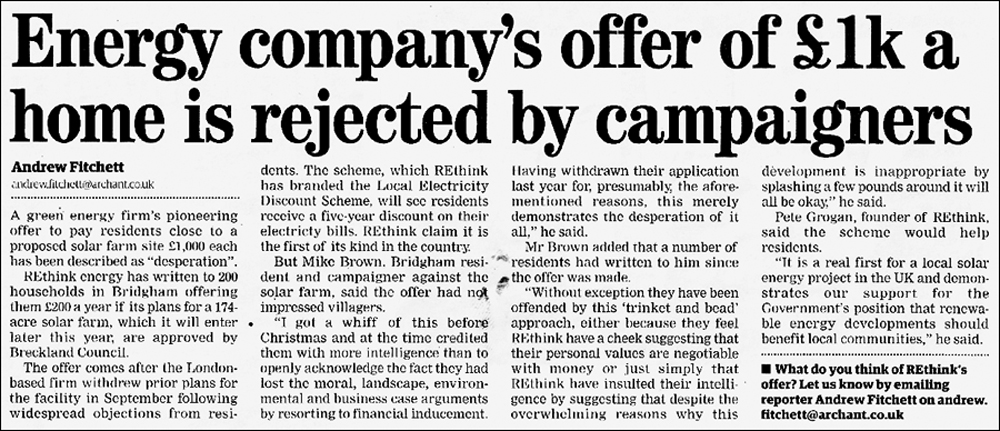
EDP 15 February 2014
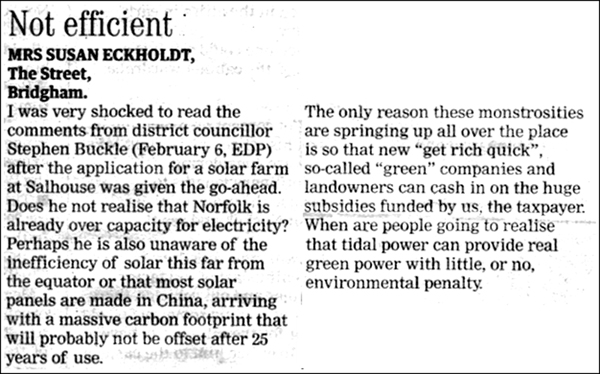
EDP 12 February 2014
Farmers Wright, Rethink and whoever ends up owning the project stand to make millions out of us, the taxpayer via ridiculous subsidies.
They
are also offering £200k to "conserve, enhance and preserve the
Brecks landscape".
Ironic
as this is the very landscape they seek to
destroy.
They claim to be forcing this upon us for the good of the planet (greenwash).
We say it is solely to make lots of money.
Can Rethink truly be
unaware of the inefficiency
of solar this far from the equator or that most solar panels are made
in China, arriving with a massive carbon footprint that will probably
not be offset after 25 years of use.
This industrial development would be three times the size of Bridgham Village and immediately adjacent.
See map below.
We are in favour of renewable energy, but not when something of this scale is being forced upon our village.
It would be
surrounded by a high security fence and CCTV cameras -
what does that bring to mind?
Exact quote from Rethink energy
'frequently asked questions and information sheet' -
"How will the local residents
benefit?
All the clean green electricity
produced will be used locally. Local
residents' will be getting clean, green energy that they can use with
pride."
According to the 'Infrastructure planning team at UK Power Networks' East Anglia is over capacity for electricity and connectivity is at saturation point. New cables will need to be laid for 10 miles to Thetford to supply London and other large cities.
"Grid
capacity worries spark UK solar farm boom"
By Matt McGrath
Environment correspondent, BBC News - 29 October 2013
The rush has been sparked by concerns that Britain's ageing electrical grid has limited capacity for renewable energy.
Environmental campaigners are concerned by the size of the solar farms being proposed.
They argue that using agricultural land for energy production is swapping one form of dependency for another.
To read in full - http://www.bbc.co.uk/news/science-environment-24659790
The Rt Hon
Gregory Barker MP The Minister for Energy and Climate Change gave a
speech to the solar PV industry on 25 April 2013.
Originally given at County Hall, Truro, Cornwall. This is an excerpt
from text of the speech as drafted, which may differ slightly from the
delivered version.
“The Coalition Government is committed to placing solar PV
at the heart of the UK’s energy mix.
We have an ambitious and hands-on strategy to drive it forward.
Solar is rightly popular. But if we aren’t careful, or if the sector
expands inappropriately, that invaluable popular public support will
slip through our fingers.
We don’t want solar to become a bone of public contention like onshore
wind.
And that is my key message today. Solar is a genuinely exciting energy
of the future, it is coming of age and we want to see a lot, lot more.
But not at
any cost… not in any place… not if it rides roughshod over the views of
local communities.”
In October
Gregory Barker went on to say - “I
want local planning authorities to be much bolder in refusing
inappropriate solar developments. If that’s not enough I will come
forward with sustainability criteria and not allow them to claim
subsidies.”
The Rt Hon Gregory Barker MP The Minister for Energy
and Climate Change
Bridgham
says NO!
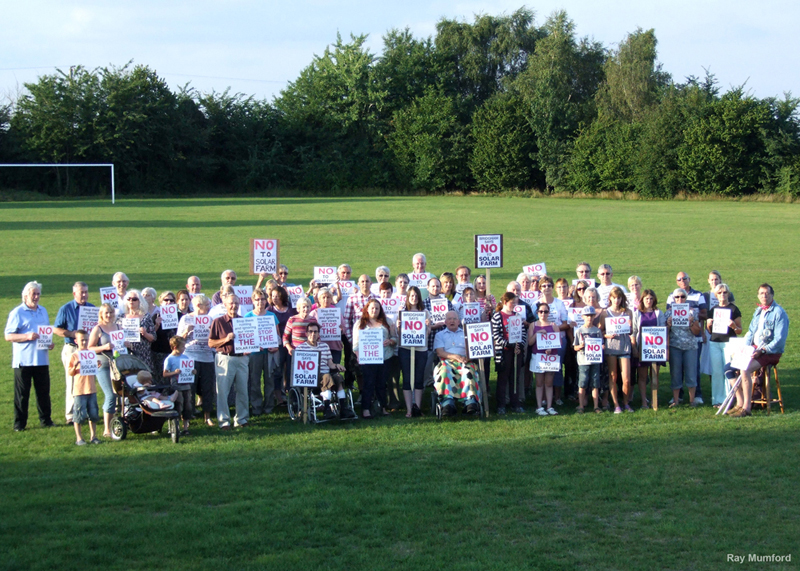
Some of the Bridgham
residents who are against the solar 'farm'.

Eastern
Daily Press 4th July 2013
A petition was conducted in August 2013 to assess the strength of feeling against the solar 'farm'.
91%
were against the development.
3% were for it.
2% were undecided or not interested.
4% Unable to comment due to association with landowner (Wright).
The petition contains 148 local
resident signatures
against the solar 'farm'.
To view the petition click this link.
Petition
Bridgham resident since 1934 said...
Having been born in this village and seen so many changes over the past 70 plus years I feel my word and knowledge should be taken note of.
In the first instance the land which will be taken by this proposed plan has always been good farm land and until the last two years, when one field has been neglected, has always to my knowledge produced good crops.
When we are already losing so much farmland to housing etc can this country sustain losing good cereal producing areas. During the 1950’s and 1960’s hedgerows were ripped out on this area and the previous five fields were reduced to two to the detriment of numerous birds and hedgerow wild flowers with the result of drying the soil out so quickly that irrigation has to be carried out.
Therefore my bone of contention is that in looking at this application errors of the past should be born in mind. If solar energy is to come why on earth are they not erected on roofs of factories etc.
We are a group of islands and therefore it make sense to use tidal power in order to retain what land we have left.
Susan Eckholdt
Bridgham resident since 1982 said...
"We are totally in favour of renewable
energy but 'solar power' is not
the answer for the UK, although it can play a part, for example on the
rooves of industrial units and high buildings, hospitals , schools etc.
When there is massive untapped,
consistent energy available from the
tides around our coast it is madness to think of covering green fields
and agricultural land in solar panels.
Tidal generators on the seabed
have a minimal impact on the environment
and the energy is there every day as a constant, regardless of whether
the sun shines or the wind blows.
Our village is outstandingly
beautiful and the area around our church
is a perfect pastoral scene, as can be seen on David O'Neale (MBE) and
Tony Dobbin's book 'Village Life, the story of Bridgham in Norfolk'.
The very idea of
defiling this land is obscene."
Keith Longmore, Chartered Engineer,
Member of the Institution of Technology and
Engineering and Member, Society of Environmental Engineers said...
"Green projects can only be considered green if they do not detract unduly from the environment and its well being. Developments on the scale of, and sited in a location such as, the proposed solar farm at Bridgham cannot by any stretch of the imagination be viewed in a positive light; indeed, the cost to the local environment at Bridgham must surely far outweigh the benefit to the country.
We
must fight to protect the environment above all else, since once the
damage is done, it can rarely be undone, and future generations will
judge us harshly indeed if we allow the short term profit of a few to
result in us bequeathing to them an environment denuded of much of its
wildlife and visual beauty."
The following shows the application for the massive 'solar farm' by Rethink Energy, Ward Hill and farmers Wright.
So far we can find no evidence that Rethink have ever done anything like this before.
They seem to have made up a set of guidelines for themselves - then immediately disregarded most of them.
Re-think website says -
Ideal sites fit the following parameters:
• Low grade, unproductive land that could be grazed by sheep
(It is productive land)
• Away from residential areas and / or through hedge and tree
planting could be screened from public view
(It is right next to the village and screening would block out the landscape)
• Close to an electricity substation
(Is 10 miles close?)
As can be seen below, the huge site would be right next to the village and the wonderful views we enjoy would be stolen from us and replaced by an industrial landscape.
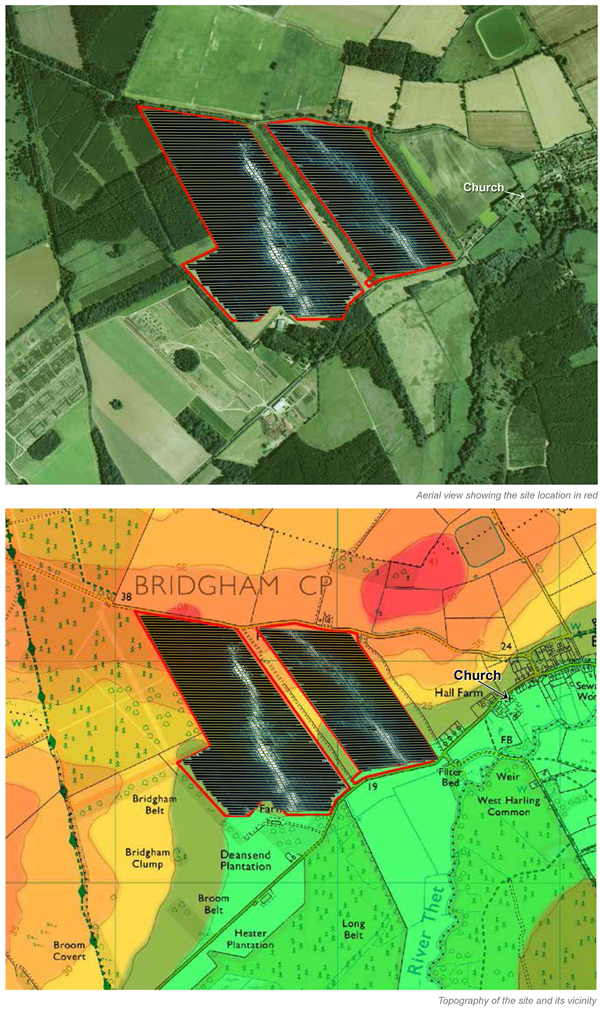
Proposed
site by Rethink Energy.
Re-think website
says - Ideal sites fit the following parameters:
"Close to an electricity
substation"
Below
is proposed 10
mile route (roads) to be dug up to lay heavy cable to
connect
solar 'farm' to national grid.
Note - solar 'farm' is shown as covering a smaller area in this plan.
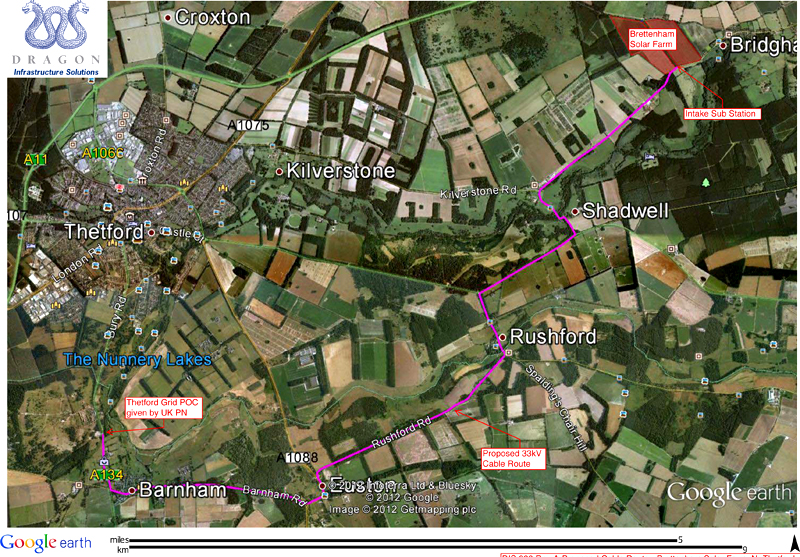
Re-think website
says - Ideal sites fit the following parameters:
"Low grade, unproductive land that
could be grazed by sheep"
The
photo below shows a small part of the right hand field, being harvested on the
13th August 2013.

Re-think website
says - Ideal sites fit the following parameters:
"Low grade, unproductive land that
could be grazed by sheep"
The
photo below gives some idea of the size of this same field which is the
smaller of the two.

The
photo below shows part of the left hand field, on the 23rd August 2013.
This the view from the Bridgham - Brettenham road.
This
track has been used for very many years and is, de facto, a public path.
Photo
John Besent OBE FRICS
It
appears, from Rethink plans, that the bottom of this path will be
blocked by security fences.

The
photo below shows part of the left hand field, on the 23rd August 2013.
This
the view from The High Bridgham Road.
This track has
been used for very many years and is, de facto, a public path.
Photo
John
Besent OBE FRICS
It
appears, from Rethink plans, that the bottom of this path will be
blocked by security fences.

"The views across the fields from this track are wonderful
and give immense pleasure and enjoyment."
"A
landscape is not an abstract thing; it is non-existent if it cannot
be seen. The construction of a solar farm would cause great harm
to the traditional landscape. Full screening would hide an
eyesore, but it would also remove the fields from the landscape and
break up its integrity. One cannot mitigate against the adverse impact
of a solar farm on the open landscape of these Breckland fields."
John Besent OBE
FRICS
These two fields
would be covered by 135,432 solar panels for 25 years.
4th July 2013
Application appears to be withdrawn - excellent - democracy
working for once?
4th August 2013
We hear the application is back despite the village
overwhelmingly objecting.
We are allowed only twenty days to object again.
24th
October 2013
Rumour
has it that Re-think is having to re-think their application and
re-submit it under the new title 'eco
park' which seems ironic as it will be surrounded by 8 foot security
fences and CCTV cameras to keep the public out.
9th June 2014
THEY
ARE BACK
''But not at any
cost… not in any place… not if it rides roughshod over the views of
local communities.”
The Rt Hon Gregory Barker MP The Minister for Energy
and
Climate Change
The following is by Elizabeth Truss MP
Now
Secretary of State for Environment, Food and Rural Affairs
Dear Bridgham Parish Council
Thank you for your
email. I have been extremely concerned by the
increasing use of agricultural land for the provision of fuel whether
this be solar plants or bio fuels. I have in the past raised
these concerns with the Department for Energy and Climate Change and
earlier this year I met with the DEFRA Secretary of State Owen
Patterson to reiterate my concerns . The DECC Minister Greg Barker
speaking in the House of Commons in January this year made the
following point:
“We need to be careful that we do not over-incentivise large-scale ground-mounted projects in inappropriate places – I am thinking of greenfield agricultural land – that could generate strong opposition to our community energy agenda… …It needs careful design and thoughtful consideration. It certainly could not be a scheme about renewable energy at any cost. Impacts on the local community, on landscape and on consumer bills have to be a real consideration…”
I am concerned that subsidies for these plants distort the market and end up competing with farming for the same resource – land. In the long run this will drive up prices and create a reduction in suitable agricultural land used for food production.
The significant opposition by local residents illustrates the lack of support for the solar farm. The location is not appropriate and with food and farming being the UK’s largest manufacturing industry any future planning proposals should ensure this sector is protected. I will urge Breckland Council to carefully consider the points I have made.
Best wishes
Elizabeth Truss MP
OBJECTION
OF JOHN BESENT
A resident of
Bridgham since 1988
2. In its introduction, the new Planning Practice Guidance for Renewable and Low Carbon Energy, issued this July by the Department for Communities and Local Government, says that Government planning practice guidance can be a material consideration in planning decisions and should generally be followed unless there are clear reasons not to. The new Guidance was introduced in order to tackle, in the words of Energy Secretary Greg Barker, the “menace of inappropriate large-scale arrays” and to ensure that localism/ local opinion, is properly taken account of. He said “Solar has a bright future in the UK, but not in any place and not at any price. I want UK solar targeted on industrial roofs, homes and brownfield sites, not on our beautiful countryside”.
3. In the Press Release of 29th July that accompanied the publication of the new Guidance, Local Government Secretary Eric Pickles said:
“The views of local people must be listened to when making planning decisions. Meeting Britain’s energy needs should not be used to justify the wrong development in the wrong location.
This new guidance is an important step in ensuring that communities can continue to shape their local surroundings and that landscape and heritage are properly considered and protected.
Planning always works best when local communities themselves have the opportunity to influence the decisions that affect their lives. That is why it is so important every area has a local plan in place as soon as possible”.
4. Time and time again, the Planning Practice Guidance emphasises the importance of local opinion.
• At paragraph 5: whilst “all communities have a responsibility to help increase the use and supply of green energy, this does not mean that the need for renewable energy automatically overrides environmental protections and the planning concerns of local communities. As with other types of development, it is important that the planning concerns of local communities are properly heard in matters that directly affect them.
• At paragraph 6: “Local and neighbourhood plans are the key to delivering development that has the backing of local communities”, and as regards green energy developments, “there is no quota which the Local Plan has to deliver”.
• At paragraph 8: “There are no hard and fast rules about how suitable areas for renewable energy should be identified, but in considering locations, local planning authorities will need to ensure they take into account..., critically, the potential impacts on the local environment” and (at paragraph 12) “the proximity of grid connection infrastructure and site size”.
• Also at paragraph 8: “The views of local communities likely to be affected should be listened to”.
• At paragraph 11: “the expectation should always be that an application should only be approved if the impact is (or can be made) acceptable”.
• And at paragraph 15: “Protecting local amenity is an important consideration which should be given proper weight in planning decisions”.
DETAILS OF MY OBJECTION
5. Turning now to the Solar Farm proposal at Bridgham, the applicant’s contention that the site is a suitable one is based on their statement that “the site lies in a relatively isolated location away from residential properties” and “has limited views from public vantage points outside the site”. Both of these assertions are false. The site is hard up against the village and only separated from the village’s former forestry cottages by a narrow grass track. On its north side, the site lies alongside the High Bridgham Road, on the opposite side of which and facing the site are two residential properties. There are also two cottages to the south west of the site. Physically, the village would be dominated by the solar farm, notwithstanding hedge screening.
6. The river Thet valley, in which the village lies, is beautiful and an important element in the landscape of the Brecks. The fields comprising the application site are an integral part of that landscape and views across these fields from High Bridgham Road and the Bridgham-Brettenham road are enjoyed by villagers and visitors alike. That has been the case for generations. Running through the centre of the site from north to south is a sandy track. This is much used by local people and although it is not a public right of way, there are prescriptive rights of passage on foot and horseback. I, for one, have walked along this track for some 24 years without permission from the landowner and without let or hindrance. The views across the fields from this track are wonderful and give immense pleasure and enjoyment. Should the solar farm proceed, these views would be lost completely and the track would become a dark, hostile place bordered on one side by an existing hedge and on the other by a 2.5m high security fence and an evergreen hedge of at least equal height.
7. In addition to the physical impact on the amenity of the village, there would be a significant malign emotional impact on the village residents. There is a wonderful community spirit in the village, which has been given a boost in recent years by the efforts of the Bridgham Millennium Group and in particular the publication in 2010 of VILLAGE LIFE: The Story of Bridgham in Norfolk.
8. I believe that the solar farm would undermine residents’ pride in their village and their sense of place. It would certainly undermine mine. It would not surprise me if Bridgham became known locally if not further afield as the ‘solar village’ and that when I am asked in which village I live and respond Bridgham, my enquirer will say “oh, I’m so sorry, that’s the village with the huge solar farm isn’t it”.
9. One of the criteria for site suitability is that there should be reasonable proximity of the solar farm to the national grid, and, ideally, the scheme should be of benefit to the local community. In the case of the proposal for Bridgham, there would be no benefit to the community and the power generated would have to be taken all the way to Thetford by cable under the highway with all the disruption that that would entail. I don’t know for sure, but I am given to understand that there is no spare capacity on the grid at Thetford and that therefore the power may have to be transmitted to as far away as London.
10. At a recent meeting of the Bridgham Parish Council, a petition was presented with 93% of respondents in the village opposing the proposed solar farm. There were only 3 people in favour with more than 100 against. To emphasise the community’s opposition to the scheme, most of the houses in the village are displaying ‘NO TO SOLAR FARM’ or other similar signs. It is quite clear, therefore, that the village does not want the solar farm on its doorstep.
11. There was a similar opposition to a proposed solar farm at Tedburn St. Mary in Devon. That proposal was for a much smaller scheme than the one proposed for Bridgham. It would cover only 40 acres and, unlike the Bridgham scheme, was to be sited the best part of a mile from the village. Notwithstanding its relatively small size and distance from the village, the scheme was rejected by the local planning authority by 15 votes to 5, against the recommendation of the Planning Officer, on account of possible impacts on the area.
SUMMARY
12. To summarise, the proposed solar farm development at Bridgham is far too big and far too close to the village. It would be a wrong development in the wrong location. The solar farm would dominate the village, no amount of screening would hide the fact that it would be there, cherished Breckland landscape views would be lost, pride in the village destroyed and the will of the community would be overridden if planning permission were to be granted. I, therefore, urge the Planning Committee of Breckland District Council to reject the application. I wish to be notified of the decision.
The Street, Bridgham
18th August 2013
ADDITIONAL
SUBMISSION OF JOHN BESENT
A resident of
Bridgham since 1988
SIZE (MW)
According to the Interactive Map of Renewable and Alternative Energy Projects in the UK, which lists major solar schemes in the UK, there are 102 schemes in operation, each generating between 1 and 35MW of electricity, and 70 schemes approved/in course of construction also generating between 1 and 35 MW. Of the total of 172 schemes, the vast majority (127) are small in size, each generating less than 6 MW. Only 12 generate 15 MW and over and only 2 generate more (35 MW) than the Bridgham scheme (30MW). It can be seen, therefore, that the Bridgham scheme is huge in relation to the vast majority of schemes; that is why its location is such an important consideration in determining this planning application.
LOCATION IN RELATION TO RESIDENTIAL AREAS AND EASE OF CONNECTION TO THE NATIONAL GRID.
Together with size, these are important factors to be taken into consideration. Paragraphs 8 and 12 of the new Planning Practice Guide for Renewable and Low Carbon Energy state that in considering locations, local planning authorities will need to ensure that they take into account, inter alia, but critically, the potential impacts on the local environment; also the proximity of Grid connection infrastructure and site size. In the Bridgham case, the local environment is the bucolic landscape of the River Thet valley and its village community of rural dwellers.
The applicants themselves acknowledge the importance of location. They say that an ideal site for a solar farm should be away from residential areas and close to an electricity substation. On their website ReThink state that they always endeavour to adapt and update their project plans following public consultations to ensure they are not missing anything vital to the local community and that the local community is happy. They go on to say that whether they need to change their site location, adjust some of the layout, or ensure that they have tailored the construction plan to suit local priorities, they will always try to help. ReThink have not responded at all to the views of the community of Bridgham.
I have examined the planning applications for the 3 largest solar farms in operation and the 3 largest approved or under construction. I have compared them with the Bridgham scheme in respect of their size in terms of acreage and power output, and their proximity to residential areas and a Grid connection. The comparisons are set out below.

1. There are a small number of residential properties 380 yds to the north east.
2. There are a small number of residential properties in the locality, the closest of which is 440 yds to the south east.
It can be seen from the above list that the proposal for Bridgham in terms of proximity to residential areas and a Grid connection contrasts markedly with the other schemes. Consequently, should planning permission be granted for the Bridgham proposal, it would be a major departure from the precedent set by the other schemes in their distance from residential areas and their closeness to a Grid connection.
ABILITY OF THE SITE TO GROW CROPS
The applicant describes the site as low quality agricultural land (grade 3b). This is incorrect as grade 3b on the Agricultural Land Classification of England and Wales is moderate quality agricultural land capable of producing moderate yields of a narrow range of crops, principally cereals and grass. The applicant states that it is poor wheat growing land. That may be so given the light and sandy nature of the soil, but I suspect it grows barley pretty well. It has grown potatoes and sugar beet. Being drought resistant, forage maize could be grown and possibly also maize for bio-fuel. It may not be economic to grow some of these crops on the land at the present time, but markets and financial support are subject to change, particularly in a world short of food.
10th September 2013
The following is taken directly from the ReThink
Energy Ltd. web site.
The key to ReThink Energy’s success is that we always work in consultation with local people and act sensitively to the needs of local residents, land owners and parish councils. A renewable energy project is for the benefit of the community first and for Britain second, and so the development of the project should be a seen as a partnership.*
At ReThink, we pride ourselves on the collaborative nature of our development process, but before we even reach the stage at which a renewable energy project appears technically suitable for a given location, the site must undergo a rigorous series of assessments for suitability and pass a set of strict planning criteria. These assessments include, but aren’t limited to:
• Landscape and Visual Impact Assessments, to ensure that local
residents’ views will not be negatively impacted
• Ecological assessments and wildlife surveys, to make sure that the
proposed project wouldn’t disturb any animals or plants currently using
the site
• Archaeological Assessments, often including full geophysical surveys to
ensure that nothing of archaeological interest would be disturbed by the
project (Often our geophysical surveys provide the first opportunity for
archaeologists to get an idea of what may lie below the land in question)
• Flood Risk Assessments
• Topographical Surveys
• Access analysis for the short construction phase, to ensure that local
traffic flow is not affected
• Analysis of potential mitigation measures
Following a successful screening using the methods mentioned above, ReThink Energy then begins community consultation. Although we are not required to discuss our proposals with the local community, much less act upon the feedback we receive, ReThink Energy places a huge amount of importance upon community consultation. We believe it’s vital to include input from the local community in the final design and layout of our projects.
ReThink always endeavour to adapt and update our project plans following public consultations to ensure we’re not missing anything vital to the local community and that the local community is happy. Whether we need to change our site location, adjust some of the layout, or ensure that we’ve tailored the construction plan to suit local priorities, ReThink will always try to help."
http://rethink-energy.co.uk/our-projects.html
*Norfolk is over capacity for electricity, requiring new cables to be laid to Thetford, and it is London that needs this.
Contrary
to the company's claims above they
are completely
ignoring the feelings of the local residents and the needs of the
wildlife.
Rethink seem determined to bulldoze this through
regardless.
From David O'Neale to Ward Hill
Reflections on
Solar Panels 'Application pack'
Sent to Ward Hill before they withdrew their application,
but when
they resubmitted it they didn't bother to adopt any of the corrections.
Here are points I would like to correct (pg numbers refer to the book 'VILLAGE LIFE' see below):
a) There are several references to Oakwall Cottage. It is in fact, Oakwell Cottage. See pg 59 and images of diamond mullioned wooden window frames.
b) The report says at least twice that the school shut in 1951/2. In fact, it closed in 1978, a year after its centenary celebrations (pgs 191-99).
c) The report states that Bridgham was owned by Ely Cathedral until the 17th century. Actually, it was appropriated by the Crown in 1558, which is the 16th century. (pg. 55 and for the Bishop’s survey of Bridgham in 1251, see pgs 26-39 which includes all the field names. (Pgs 108-109 list the field names in 1251, 1558, 1734 & 1838).
d) The report says that my house, Mill House was possibly built in 1808 at the same time as the postmill. However, my house is clearly visible on the 1806 Enclosure Map and Faden’s map of 1797, which are in your report.
e) On page 19 of the report it states that there are no WW2 sites. This is completely untrue. Just north of High Bridgham Rd, the first ever Typhoon crashed killing the pilot in 1943 (R7592), pg 157. In the same year, an American B-17 Flying Fortress bomber (The Spirit of St Louis) crashed on the Bridgham/West Harling border killing all ten airmen. Pgs 167-69. Debris is still being discovered at the crash site, eg. Bullets and pressure gauge imbedded in trees. A Wellington crashed at Broom’s crossing but was repaired and took off again. A Lancaster crashed outside Roudham Hall and eight airmen were killed. I don’t understand why your researcher didn’t consult Merv Hambling’s: Norfolk Air Crashes; RAF 1939-45 & Norfolk Air Crashes; USAAF, 1943-35. I have been told that there was a searchlight battery on High Bridgham Rd and that very near the designated site was a MOL camp for the unemployed from the north who lived in Nissen huts at Bridgham Paddocks and on West Harling Common. I think it was in the 1930s before the war started. Pg 154
f) VIKINGS There is not much information in the report on the Viking presence in Bridgham. For very good reasons, we had Viking re-enactment weekends in Bridgham in 2007 and 2010. In 1010, The Battle of Ringmere took place on the boundary of Bridgham, thousands of Vikings came up from Suffolk and destroyed ‘the flower of the English’. Pgs 8-18. About 25 years ago, I was told that scouts or cubs were digging by the river Thet at Harling Thorpe and uncovered Viking skeletons.
g) PILGRIM ROUTE Coming up from West Harling on Forestry Track 76, there has been a bridge here since time immemorial – hence the village’s name, which is Saxon. It is believed this became a pilgrim route to the shrine of Our Lady at Walsingham. Medieval pilgrims would have then walked up what we now call Trickle Lane which appears on all the maps in your report. In the 1797 map, instead of going straight up as it does now, the path veers to the left and crosses what is envisaged as solar panel field one. This seems to contravene your conclusion on pg 55 of your Landscape and Visual assessment which states: ‘Major views: no public rights of way or highways with direct, open and proximate views of the application area.’ Walsingham became a place of pilgrimage in 1061, so Trickle lane has probably been a right of way for at least 950 years.
h) NHER 51390 in the archaeology report it says this is a medieval well, close to the Peddars Way. However, the well is very close to the Roman settlement on the Brettenham/Bridgham border, with a Saxon cemetery built on top. So this may be a concern to consider. When I was compiling Village Life a county archaeologist told me that all the evidence points to there being a silver or gold hoard in Bridgham.
i) ECOLOGY: You may wish to refer to pgs 310-19 of Village Life written by a botanist and bird-watcher.
j) MYSTERY HOUSE: On page 9 of your Landscape and Visual assessment there is a photo of a house which one presumes to be in Bridgham. However, I don’t recognise it. It is close to the pavement with a flint wall and a buttress. We photographed every house in Bridgham for the Village Life book and I can’t work out where it is. I have even used Streetview on the internet and still can’t spot it. Is it really in Bridgham?
David O'Neale MBE
Thank you for your hand-delivered letter with FAQs which I received yesterday. It seems they were only given to those who had objected to your plans, rather than informing every household in the village. To me, this shows you are clearly rattled and it smacks of desperation.
You make reference to solar panels on the roof of the White House. 21 years ago, when Bill Clinton was successful in getting into the White House, one of his campaign slogans was
‘It’s the economy, stupid!’
The slogan for my campaign is
‘It’s Location, Location, stupid!’
What most of the residents object to is the siting of the Solar Farm up against Forestry Cottages. Many of us enjoy the spectacular view from High Bridgham looking down on the Thet Valley to the medieval church. There is no way that boundary hedging will hide that eyesore and there are two houses at High Bridgham which will have a view of it.
North of the A11, yet still in Bridgham is part of the Batttle Area where sheep graze. There are no houses nearby. Why don’t you put it there and pay the MoD for rental? Another possibility is the vast Shadwell Park at Brettenham which extends virtually to Thetford. Most of it can’t be seen from the road so there would be no visual objection. Also, it is nearer Thetford so would cost less to connect the cables to the town. Many of us think that Solar Power is a good idea, but you have to be sensitive as to where you place it.
In today’s Eastern Daily Press you are quoted as saying, ‘the Hall Farm project will primarily supply Thetford and Bridgham.’ This appears to be misinformation to me as we have been told that power generation in Norfolk exceeds demand. We have been informed that Thetford may not use the electricity and it may go to London. Ward Hill were clear in explaining to us that Bridgham would get no benefit. We will not get cheaper electricity for having to put up with this eyesore.
In many places in Norfolk, when small housing developments receive planning permission, the company is often obliged to provide a building for the community such as a village hall or sports pavilion. But here in Bridgham, we are promised nothing.
Ward Hill’s archaeological report was so riddled with errors I suggested they should have consulted Village Life, The Story of Bridgham in Norfolk. When they temporarily withdrew their application they had already received my correction list of their report. However, when they resubmitted the report, they didn’t change a single word. Given this cavalier attitude, I have no faith in what Rethink Energy Limited and Ward Hill may tell us, especially in the FAQs.
You may be interested in pages 256-7 of Village Life which deals with our successful protests about other planning applications. In the 1980s, Atlas Aggregates wanted to extract gravel south of the river Thet. The proposal was rejected and according to planning officials involved at the time this was largely due to the anti-campaign, which reportedly was one of the most effective the county council had ever seen. It was also the biggest number of objections they had ever received. Even Prince Charles wrote a letter of support which was placed in the village shop window.
Five years ago, gravel extraction on Manor Farm became another planning issue. Bridgham and Harling between them made such a fuss that the application was withdrawn. So you see what you are up against with both Bridgham residents and Harling Parish Council against your proposals.
Health issues. Your FAQs make out that the Solar Farms are safe for human health, but many of us have seen websites about inverters and how they can affect humans, particularly children and people with epilepsy. We would like to have some accurate answers on these issues. Has any research been undertaken? And how might effect sheep which then enter the food chain?
15 years ago we set up the Bridgham Millennium Group. Part of its constitution states:
In celebrating and enhancing the community, heritage and environs of Bridgham:
(a) To improve the social and physical environment of the village both now
and for the future.
(b) To promote in residents a greater cultural/historical understanding of the village’s heritage and their active participation in its preservation.
So it is clear you have a fight on your hands.
A month ago, I received an MBE from Her Majesty the Queen at Windsor Castle for services to the community of Bridgham. So you can see, I will continue to serve the community and many of the residents agree with me in objecting to the siting of this Solar Farm.
Yours sincerely
David O’Neale MBE
Note - Planning Applications can be continuously amended during the process, so keep checking for any changes on the planning website which could make some points on this site out of date.
